Welcome, commons-ers! For those new here, On the Commons explores the ancient roots and ongoing consequences of private property and commodification—from the Doctrine of Discovery to ancient enclosures of the commons, and more—along with love for this world and being human in the middle of systems that often make such “being” difficult.
Pre-orders are open for Elementals, a new anthology from the Center for Humans & Nature: “The Elementals series asks: What can the vital forces of Earth, Air, Water, and Fire teach us about being human in a more-than-human world?”
I have an essay titled “Trespassing” in Air, alongside some writers I admire so much I stalled out writing my own draft for months, like Báyò Akómoláfé, Ross Gay, and Roy Scranton. Other volumes include writing from Robin Wall Kimmerer, Tyson Yunkaporta, Joy Harjo, and many more. As with their previous series Kinship, I know this anthology will bring healing and guidance to a world sorely in need of both. Elementals is published September 3, 2024. Pre-orders help get the word out!
This last weekend I was camping with my family. We managed a hike through the woods to a waterfall before rain started soaking us in earnest, and spent the night in tents pummeled with 50-mph (about 80 kph) winds and relentless rain, snow, and graupel. But every moment we stayed was a choice, including the time spent in a warm car playing Exploding Kittens while hail fell, and the ability to pack up and drive home right after sunrise. Not everyone has such choices.
5% of this quarter’s On the Commons revenue will go to the Flathead Warming Center, a low-barrier houselessness shelter. The Center is facing some serious neighborhood and city resistance in its Kalispell, Montana, home, where city council is considering pulling its permit. I can’t tell you how much houseless support my area lacks, and needs—needs that the FWC has been working to meet for years despite local political resistance, but with local backing in various forms that crosses all kinds of societal lines. Wherever you are, I hope you find ways to support similar endeavors.
Audio version:
“It feels healing,” I told the guy pointing a camera at me, every joint and muscle aching and my forearms scored with cuts. “For the land, I mean. Trail work is harder, but taking down all this barbed wire? It feels like it’s healing something.”
I feel like a dork saying such things, even when I know they’re true, and even when I know my words, if I can find the right ones for honest sentiment, might persuade a few more people to sign up for volunteer work like this, spending two full days in the sagebrush terrain of southwest Montana removing miles of barbed wire fencing for the purposes of easing pronghorn migration corridors. To wake up to birdsong and near-freezing temperatures and gather just past 7 in the morning to carpool (or truck-pool; even my sturdy Subaru couldn’t handle the two-track dirt ruts we had to drive) to the work site and don work gloves heavy enough to withstand the fierce jabs of old barbed wire.
The cameraperson asked me about my bleeding arms and I said I should have worn a long-sleeved shirt. “This is called poor choices in safety equipment,” I said.
I was desperately tired at that point, as well as bleeding. We were nearing the end of the 2.3 miles (about 3.7 km) of fencing, and I’d spent most of my time rolling up reams of 5-strand wire after others on the crew had gone ahead clipping it from fenceposts and those behind were using a hydraulic jack to remove stubborn T-posts (those are metal fenceposts, as opposed to the wooden ones, many of which came out easily or were broken from rot). It didn’t seem like much, walking through tough sagebrush while winding springy, cantankerous barbed wire around itself, but the hours and miles piled up.
While my own body wanted to rebel against the work and the eventual heat of the day, wanted to jump into the rushing creek and rest under the aspens growing alongside it, watch the camas grow and the water flow, it did, still, feel healing. While we worked, a couple pronghorn in the distance slipped under barbed wire fencing. Pronghorn, as I wrote about when I first did this kind of work three years ago, won’t jump fences. They slip underneath, and that bottom strand of sharp barbed wire often results in injury. Taking out the fencing, or replacing that one strand with smooth wire, removes a barrier in their migration corridor that they’d never asked for and hadn’t agreed to.
It felt good to know that after over a century of damage and abuse of this land, we were doing something, even a small thing, to improve the lives of those who live on it. I can’t think of many better ways to spend my not-quite-free time.

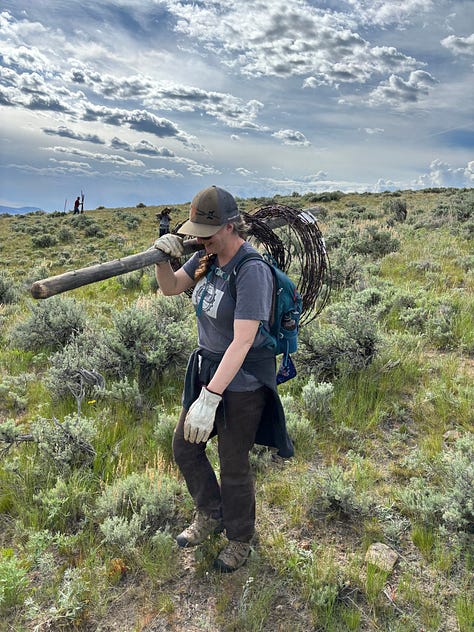
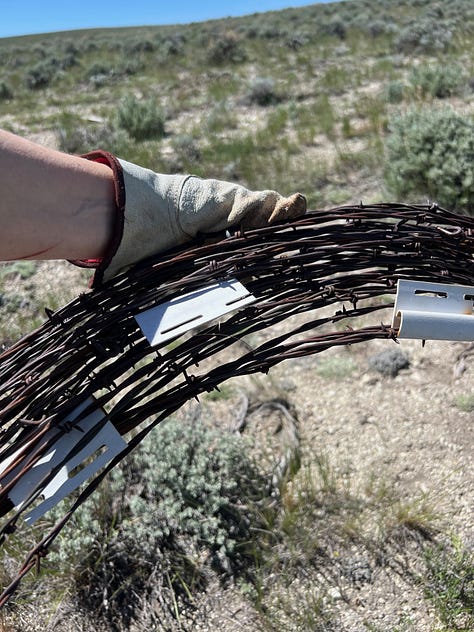
Earlier in the spring, before what I’m starting to think of as my personal “grueling volunteer labor season” began, I was at a Montana Master Naturalist gathering, with short classes on botany, geology, and meteorology (which is where I finally learned how graupel—a hail-like snow that’s always intrigued me—is formed). During a walk with a professional botanist, we smelled the butterscotch scent of Ponderosa pine’s bark and came across young camas not quite in bloom, and I got distracted by varieties of forget-me-nots, a flower I have a special, very personal, affection for.
The botanist didn’t make a lot of commentary, but while we were focused on the camas leaves, he told us about how nearby Blackfoot Valley had once been covered in camas. Entire peoples could gather there, he said, and be fed.
“Then Europeans came and turned that entire valley into cow food.”
Much as this story isn’t new or surprising, that line still hit like a blow. I’ve driven through that beautiful valley more times than I can count, tried to rein in grief and anger at the ubiquitous fencing, the “No Trespassing” signs, the dammed river, the cattle. Imagining it without said fencing, signs, dam, and cows. Imagining it, now, covered in purple camas spread widely enough for nobody who comes there to go hungry. As a place of gathering, celebration, community harvesting and cooking, sharing, and safety.
On the trail maintenance crew I worked on in designated wilderness a few weeks later, the crew leader and I came across abandoned wire—smooth, not barbed. I tripped over it. “Telephone wire,” he told me as we gathered some of it up. “The Forest Service used to be responsible for maintaining a phone line all the way from here to Ovando.” I thought of the vast mountains between Ovando and where we were, our long, harsh winters, and the seeming insanity and waste of trying to keep an operational phone line between the two.
This society we live in operates on such insanity. Survey markers, fences, hard borders, and laws separate life, and technologies like phone lines and highways reconnect, but only in the narrowest, and often most destructive, ways. As if we keep trying to meet some innate, unavoidable need but using all the wrong methods. I can’t reconcile the theft and conversion of the Blackfoot Valley from shared camas to private cow food, with the fact Ovando, which is in that valley, was for a few decades connected by telephone across a mountain range.
Sarah Augustine, a Pueblo (Tewa) descendant and cofounder of the Coalition to Dismantle the Doctrine of Discovery, wrote about private land ownership’s multi-generational destruction of community and survival in her book The Land Is Not Empty:
“Private property is an erosion of community and collective identity, survival strategies core and fundamental to humanity. Private property is divisive for all people. Private property disconnects us from each other and from responsibility for each other. This is true for all people groups, not just for the Yakama, not just for Indigenous peoples.”
The answers are right in front of us, if only the barriers in our minds, barriers forwarded and maintained by power and insatiable want, could find ways to dissolve. Make their ways back to seeing generosity and care, and shared responsibility, over manufactured scarcity and perceived fear as not only preferable, but perfectly possible.

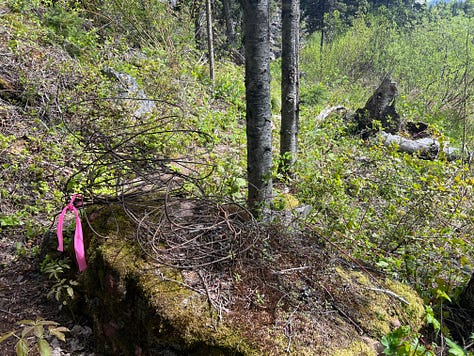
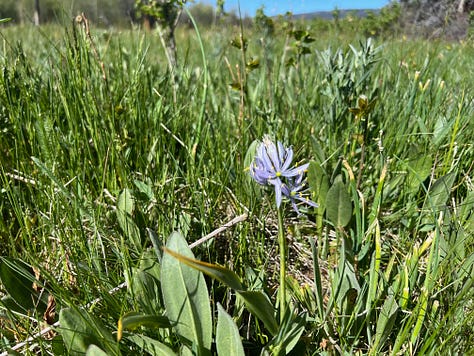
It was hard not to think of that line about camas and cow food during my weekend removing fencing. We removed two different sections of fence, and near both of them I saw camas in bloom, most of it on private land. Which means that this beautiful little purple flower, this source of nutrition, sustenance, and ceremony for many, is all too often and through no choice of her own, barricaded behind legal and physical lines of private property—property most often used to raise cattle.
I wrote a piece about borders a few months ago that probably had more and longer comments than nearly anything I’ve written here. For those who have been around this conversation-heavy newsletter a while, you know that’s saying a lot. Borders are physical, but they are also emotional, social, psychological, and cultural. And legal. The strongest borders of all might be in our own imaginations, in the belief that any of us have a right to own anything at all, especially other forms of life, and especially that any of us have the right to deny access to life, to survival, to anybody else.
How do you get a culture that believes in barbed wire fencing and private property rights but not in a right to survival? This question has come up in this newsletter more times than I can count, and I doubt that will change. It’s an ancient struggle fed by an ability to accumulate power and resources, and resistance against the same.
I brought home a short cut of barbed wire and put it on my desk to remind me of the purpose of this work: to find ways of helping us all see a world where that kind of technology has no place.
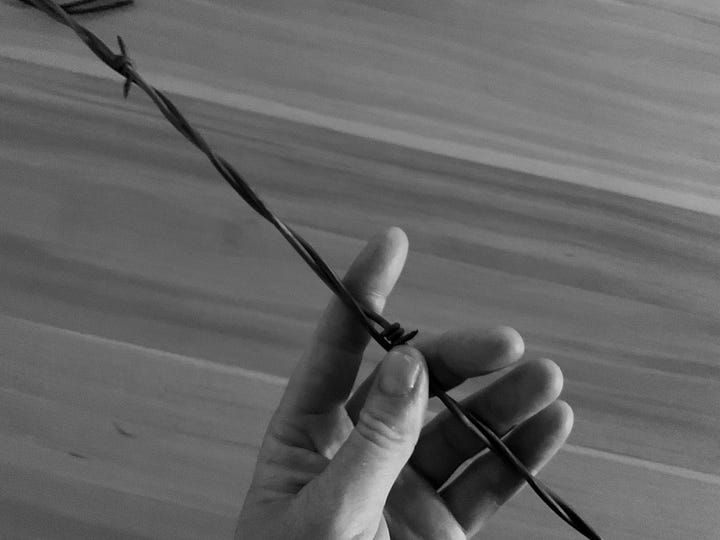

Some audio of this scene, starting a pre-fence removal day making coffee, hot some-kind-of-mush breakfast, and reading Priyanka Kumar’s Conversations With Birds—with actual birds, too—if you feel like starting a recent chilly morning with me.



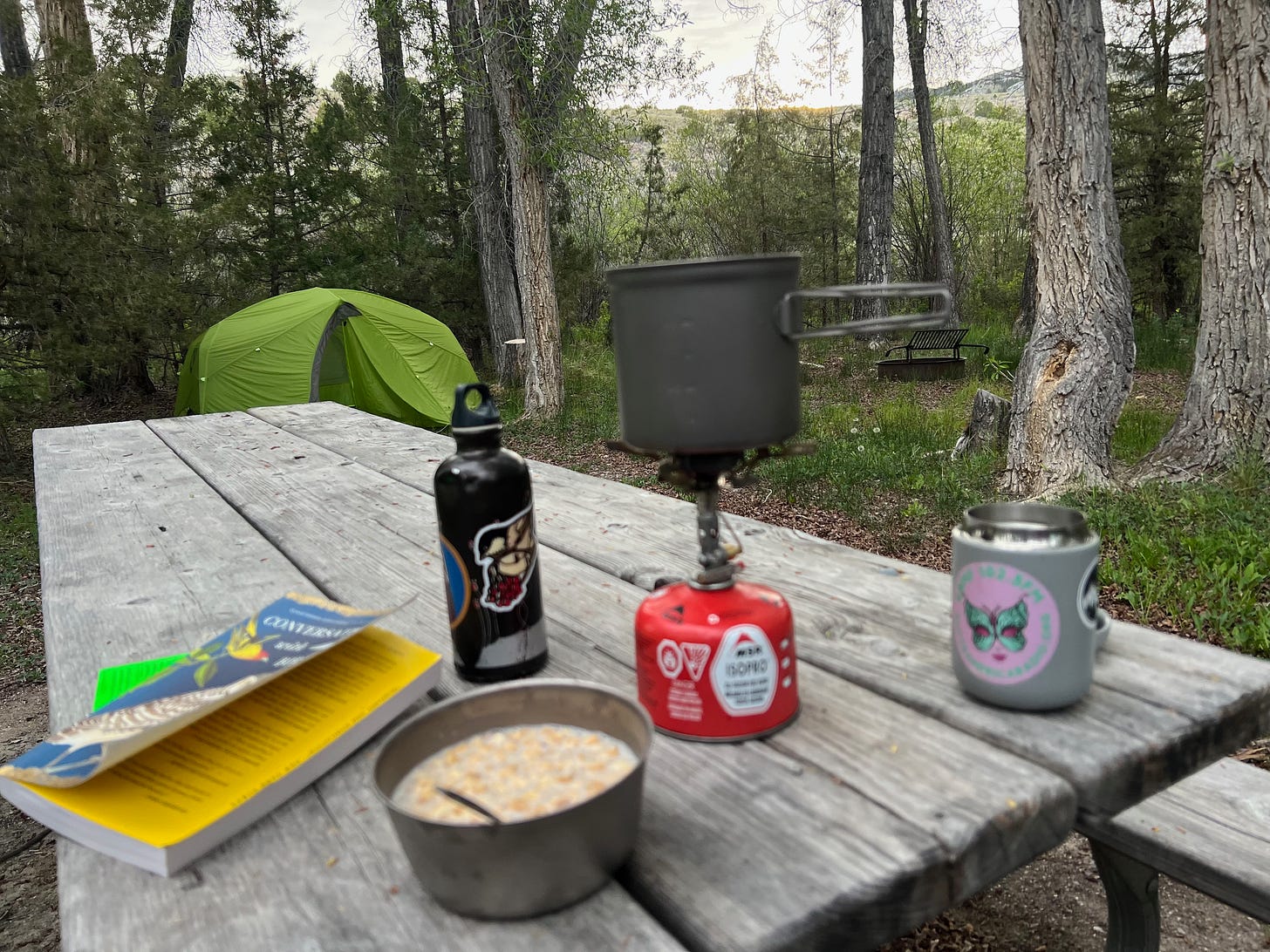
Yes, once again the story of camas being eradicated for "cow food" reminds me that the "wasteland" of Australia was more akin to prairie before sheep and rabbits gobbled it all up. Time to turn it back to living land. I bought a sweetgrass basket in Charleston. It's a work of art, but it's to remind me of what I read in Braiding Sweetgrass, when I look at it.
Amazing volunteer work you are doing. Breaking up the borders, fences, and obstacles that hamper earth's natural flow in any way we can is moving in the right direction. Thank you for doing the work and sharing it with your readers.